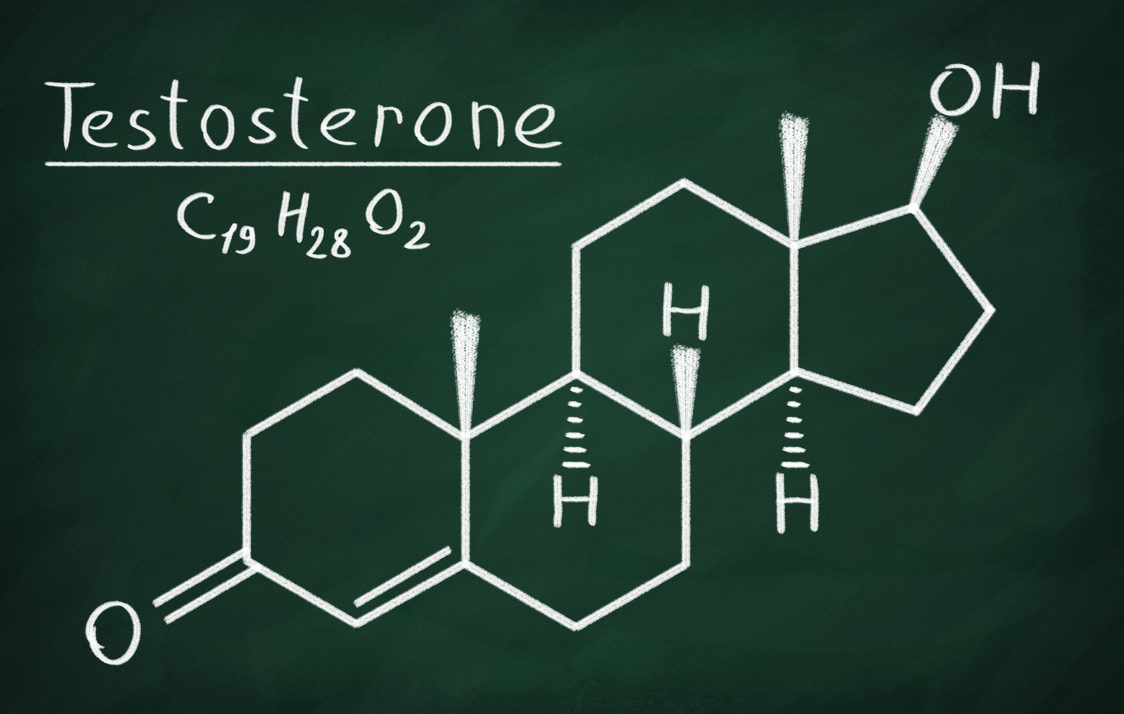Table of Contents
Testosterone levels are one of the key factors for muscle growth and strength. This is influenced by d-aspartic acid, which we would like to introduce to you in this article. In addition to that, you will learn what other effects it has on our body and from what sources we can receive it.
Let’s start with the basics
D-Aspartic acid (DAA) is one of two forms of aspartic amino acid. The second form is the so called l-aspartic acid. [1]
DAA acts in the central part of the brain, where it causes the release of hormones such as luteinizing hormone, follicle stimulating hormone and muscle hormone. However, it can also be formed in the testicles, alleviating the rate of limitation for testosterone synthesis, leading to an overall increase in testosterone levels in the body. [2]

D-Aspartic acid is also used as a testosterone booster in men suffering from infertility and in active athletes who are trying to increase muscle mass. However, it has been shown that increased testosterone levels in healthy men only last for a week before returning to their original levels. [3]
You might be interested in these products:
DAA is also found in the food
D-Aspartic acid is a naturally occurring form of one of the 20 major structural amino acids. At the same time, however, DAA is naturally found in the diet, with some food sources containing a large dose of this biogenic amino acid. [4]
DAA is naturally found in the following sources [5]:
- soy protein (9%)
- corn (40%)
- casein (31%)
- vegan bacon (meatless, based on soy extract – 13%)

It has been found that d-aspartic acid can also be formed from l-aspartic acid during cooking or heating food. Even during the pasteurization process of raw dairy products, it was found that the DAA level doubled from 1.5% to 3%. [6]
DAA increases testosterone levels and promotes muscle growth
D-Aspartic acid causes an increase in testosterone synthesis by regulating a compound called StAR (a stimulating steroidogone acute regulatory protein) that regulates androgen synthesis in testicular cells. [7] Based on this principle, DAA is able to indirectly release luteinizing hormone (a hormone that stimulates testosterone production and affects testicular sperm production) into the pituitary gland, which is responsible for hormonal processes in the body. [8][9]
One study, which lasted 12 days, noted that d-aspartic acid was able to increase testosterone levels by 15% after 6 days and by 42% after 12 days, compared to baseline, which dropped to 22% after three days. [10] Another study has followed in which, after 90 days, it was possible to increase serum testosterone in infertile men by receiving 2.66 g of DAA by 30 to 60%. [11]

Another interesting study was conducted on athletes who were administered 3 g daily for 28 days. However, the fact is that they have not experienced increased testosterone levels with long-term use. On the other hand, this study has shown a very important induction of serum d-aspartic oxidation (DAO), which significantly degrades d-aspartic acid. [12]
Accumulation of d-aspartic acid in the front part of the pituitary gland causes an increase in the secretion rate of gonadotropin-releasing hormone (hormone regulating the activity of the gonads) and growth hormone (GHRH). [13] Thus, short-term use of d-aspartic acid appears to have effective effects in increasing testosterone levels, which are directly related to muscle mass growth.
Benefits that both men and women will appreciate
For men, DAA, in addition to increasing testosterone levels and thus muscle growth, is very important in sperm formation. One study has shown that d-aspartic acid is present in the process of spermatogenesis, i.e. sperm formation. It also affects their quality and improves reproduction in men. In addition, by increasing testosterone, it acts as a sexual stimulant and increases sexual desire. [14]
For women, d-aspartic acid may play an important role in sexual life and reproduction. The study found that DAA was found to be a physiological component in a follicular fluid that decreases with age and affects the reproductive potential of women. [15] It can therefore have a positive effect on women during menopause but also at working age, promoting reproductive potential and increasing libido. [16] However, for women, the use of DAA should be consulted with a specialist or physician.
Improves memory and brain activity
Recent studies have found that d-aspartic acid acts as an endogenous neurotransmitter. This means that it is also a substance that can link “communication” between individual neurons. This process serves as a “brain cleansing” and it has been found that the presence of DAA in this process improves memory, overall brain activity but also concentration. [17]
Who should consider taking DAA?
For many people, d-aspartic acid provides benefits. However, there are also people who should consider using it more thoroughly.
We recommend using DAA if:
- You are a man over the age of 21 and have problems with low testosterone.
- You are looking for a natural way to increase the production of endogenous anabolic hormone.
- You have low libido and feel that your muscles cannot recover so quickly after training.
- Note: It is an advantage if you continuously monitor your testosterone levels while taking DAA.

Do not consider taking DAA if:
- You are a woman, you should consult your doctor about taking DAA.
- You are less than 21 years old and have increased testosterone levels.
- You are fighting increased levels of DHT (dihydrosterone) or estrogen.
- You suffer from hyperthyroidism. [18]
How often should you take DAA?
The standard daily dose of DAA ranges from 2000 to 3000 milligrams. DAA is therefore a dietary supplement that is taken daily. However, opinions differ. One study was conducted with a daily dose of 3000 mg for 12 days followed by a one week pause. The second study continued without a break at a daily dose of 2000 mg and showed no difference in outcome or other negative effects. [19] It is up to you to decide whether to take DAA with or without breaks, but always read the information on the product label.

We believe that we have shown you the benefits of d-aspartic acid and how it affects our body. If you liked this article, share it to support it.
[1] D'Aniello A - .D-Aspartic acid: an endogenous amino acid with an important neuroendocrine role. Brain Res Rev. 2007 – https://www.ncbi.nlm.nih.gov/pubmed/17118457
[2] Man EH, Sandhouse ME, Burg J, Fisher GH - Accumulation of D-aspartic acid with age in the human brain. Science. 1983 – https://www.ncbi.nlm.nih.gov/pubmed/6857259
[3] Gemma D’Aniello, Salvatore Ronsini, Tiziana Notari, Natascia Grieco, Vincenzo Infante, Nicola D’Angel, Fara Mascia, Maria Maddalena Di Fiore, George Fisher, Antimo D’Aniello - D-Aspartate, a Key Element for the Improvement of Sperm Quality. Scientific Research An Academic Publisher Vol.2 No.4, October 2012 – http://www.scirp.org/journal/PaperInformation.aspx?paperID=24016
[4] E H Man, and J L Bada - Dietary D-Amino Acids. Annual Review of Nutrition Volume 7, 1987 – https://www.annualreviews.org/doi/abs/10.1146/annurev.nu.07.070187.001233?journalCode=nutr
[5] E H Man, and J L Bada - Dietary D-Amino Acids. Annual Review of Nutrition Volume 7, 1987 – https://www.annualreviews.org/doi/abs/10.1146/annurev.nu.07.070187.001233?journalCode=nutr
[6] Friedman M. - Chemistry, nutrition, and microbiology of D-amino acids. J Agric Food Chem. 1999 – https://www.ncbi.nlm.nih.gov/pubmed/10552672
[7] Yoshiko Nagata, Hiroshi Homma, Megumi Matsumoto, Kazuhiro Imai - Stimulation of steroidogenic acute regulatory protein (StAR) gene expression by d-aspartate in rat Leydig cells. FEBS Letters -Volume 454, Issue 3, 9 July 1999, Pages 317-320 – https://www.sciencedirect.com/science/article/pii/S0014579399008406
[8] D'Aniello A, Di Cosmo A, Di Cristo C, Annunziato L, Petrucelli L, Fisher G. - Involvement of D-aspartic acid in the synthesis of testosterone in rat testes. Life Sci. 1996 – https://www.ncbi.nlm.nih.gov/pubmed/8699926
[9] Wolosker H, D'Aniello A, Snyder SH. - D-aspartate disposition in neuronal and endocrine tissues: ontogeny, biosynthesis and release. Neuroscience. 2000 – https://www.ncbi.nlm.nih.gov/pubmed/109964687
[10] Topo E, Soricelli A, D'Aniello A, Ronsini S, D'Aniello G. - The role and molecular mechanism of D-aspartic acid in the release and synthesis of LH and testosterone in humans and rats. Reprod Biol Endocrinol. 2009 – https://www.ncbi.nlm.nih.gov/pubmed/19860889
[11] Gemma D’Aniello, Salvatore Ronsini, Tiziana Notari, Natascia Grieco, Vincenzo Infante, Nicola D’Angel, Fara Mascia, Maria Maddalena Di Fiore, George Fisher, Antimo D’Aniello - D-Aspartate, a Key Element for the Improvement of Sperm Quality. Scientific Research An Academic Publisher Vol.2 No.4, October 2012 – http://www.scirp.org/journal/PaperInformation.aspx?paperID=24016
[12] Errico F, Pirro MT, Affuso A, Spinelli P, De Felice M, D'Aniello A, Di Lauro R. - A physiological mechanism to regulate D-aspartic acid and NMDA levels in mammals revealed by D-aspartate oxidase deficient mice. Gene. 2006 – https://www.ncbi.nlm.nih.gov/pubmed/16516413
[13] Pampillo M, Scimonelli T, Bottino MC, Duvilanski BH, Rettori V, Seilicovich A, Lasaga M. - The effect of D-aspartate on luteinizing hormone-releasing hormone, alpha-melanocyte-stimulating hormone, GABA and dopamine release. Neuroreport. 2002 – https://www.ncbi.nlm.nih.gov/pubmed/12488823
[14] D'Aniello G, Ronsini S, Guida F, Spinelli P, D'Aniello A. - Occurrence of D-aspartic acid in human seminal plasma and spermatozoa: possible role in reproduction. Fertil Steril. 2005 – https://www.ncbi.nlm.nih.gov/pubmed/16275242
[15] D'Aniello G, Grieco N, Di Filippo MA, Cappiello F, Topo E, D'Aniello E, Ronsini S. - Reproductive implication of D-aspartic acid in human pre-ovulatory follicular fluid. Hum Reprod. 2007 – https://www.ncbi.nlm.nih.gov/pubmed/17951582
[16] Hsu C, Hsieh YL, Yang RC, Hsu HK. - Blockage of N-methyl-D-aspartate receptors decreases testosterone levels and enhances postnatal neuronal apoptosis in the preoptic area of male rats.Neuroendocrinology. 2000 – https://www.ncbi.nlm.nih.gov/pubmed/10859492
[17] D'Aniello S, Somorjai I, Garcia-Fernàndez J, Topo E, D'Aniello A - D-Aspartic acid is a novel endogenous neurotransmitter. FASEB J. 2011 – https://www.ncbi.nlm.nih.gov/pubmed/21163862
[18] D'Aniello, A. (2007). D-Aspartic acid: an endogenous amino acid with an important neuroendocrine role. Brain research reviews,53(2),215-234. – https://www.muscleandstrength.com/expert-guides/d-aspartic-acid
[19] Melville GW, Siegler JC, Marshall PW - Three and six grams supplementation of d-aspartic acid in resistance trained men. J Int Soc Sports Nutr. 2015 – https://www.ncbi.nlm.nih.gov/pubmed/25844073


Add a comment